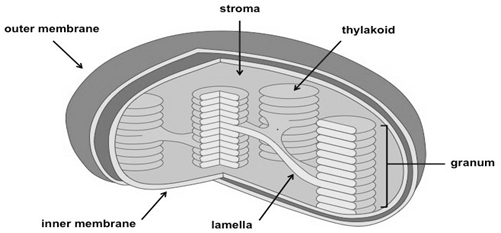
Concept explainers
To determine:
The cellular structures are necessary for photosynthesis.
Answer to Problem S3.3BYB
Solution:
Chloroplast are necessary for photosynthesis,
Explanation of Solution

Photosynthesis is an important biological process. It’s only used by plants and other microorganisms to convert light energy into chemical energy that can later be released to energy the organisms.
Plastids
The plastids are cell organelles that are found in the plant cells only and some unicellular organisms (Euglena) of uncertain similarity. These can be classified into several types, depending upon the nature of the pigments they contain. Chloroplasts contain chlorophyll pigments, while chromoplasts contain pigments other than chlorophyll. The leucoplasts are devoid of any pigment. However, they have the capacity to develop pigments as and when necessary. Chlorophyll is the green colored pigment present in the chloroplast of the plant cell. It performs the function of trapping light energy and converts into chemical energy.
Different structures of chloroplast:
The chloroplasts are found in the leaves of green plants and are the most common and biologically important plastids. Fungi lack chloroplasts and are, therefore, heterotrophic. The form varies with the species and organisms. It may be ribbon-like, reticulate, cup-like, spiral, discoid, spherical or ovoid. In higher plants, it is generally discoid in shape. The diameter of chloroplast varies from 4-8 mm. It is about 2 mm thick. Most of the algal cells possess a single chloroplast. In higher plants, however, the number varies from 20-40 per cell.
Importance of Chloroplasts:
(i) Chloroplasts are able to trap solar energy and change it into chemical energy. All living organisms use this chemical energy to perform their life activities.
(ii) Chloroplasts fix up carbon dioxide and release oxygen during photosynthesis. This keeps the percentage of two gases balanced in the atmosphere.
(iii) They store starch either temporarily (e.g. in higher plants) or permanently (e.g. in several algae).
The chloroplast is cell organelle and it is equivalent to mitochondria because it possesses DNA, therefore, chloroplast is known as semiautonomous cell organelle. And chloroplasts may change into chromoplast to provide colors to many flowers and fruits to attract animals. Hence, Chloroplast cellular structures are necessary for photosynthesis.
Want to see more full solutions like this?
Chapter 8 Solutions
Inquiry into Life
 Human Anatomy & Physiology (11th Edition)BiologyISBN:9780134580999Author:Elaine N. Marieb, Katja N. HoehnPublisher:PEARSON
Human Anatomy & Physiology (11th Edition)BiologyISBN:9780134580999Author:Elaine N. Marieb, Katja N. HoehnPublisher:PEARSON Biology 2eBiologyISBN:9781947172517Author:Matthew Douglas, Jung Choi, Mary Ann ClarkPublisher:OpenStax
Biology 2eBiologyISBN:9781947172517Author:Matthew Douglas, Jung Choi, Mary Ann ClarkPublisher:OpenStax Anatomy & PhysiologyBiologyISBN:9781259398629Author:McKinley, Michael P., O'loughlin, Valerie Dean, Bidle, Theresa StouterPublisher:Mcgraw Hill Education,
Anatomy & PhysiologyBiologyISBN:9781259398629Author:McKinley, Michael P., O'loughlin, Valerie Dean, Bidle, Theresa StouterPublisher:Mcgraw Hill Education, Molecular Biology of the Cell (Sixth Edition)BiologyISBN:9780815344322Author:Bruce Alberts, Alexander D. Johnson, Julian Lewis, David Morgan, Martin Raff, Keith Roberts, Peter WalterPublisher:W. W. Norton & Company
Molecular Biology of the Cell (Sixth Edition)BiologyISBN:9780815344322Author:Bruce Alberts, Alexander D. Johnson, Julian Lewis, David Morgan, Martin Raff, Keith Roberts, Peter WalterPublisher:W. W. Norton & Company Laboratory Manual For Human Anatomy & PhysiologyBiologyISBN:9781260159363Author:Martin, Terry R., Prentice-craver, CynthiaPublisher:McGraw-Hill Publishing Co.
Laboratory Manual For Human Anatomy & PhysiologyBiologyISBN:9781260159363Author:Martin, Terry R., Prentice-craver, CynthiaPublisher:McGraw-Hill Publishing Co. Inquiry Into Life (16th Edition)BiologyISBN:9781260231700Author:Sylvia S. Mader, Michael WindelspechtPublisher:McGraw Hill Education
Inquiry Into Life (16th Edition)BiologyISBN:9781260231700Author:Sylvia S. Mader, Michael WindelspechtPublisher:McGraw Hill Education





